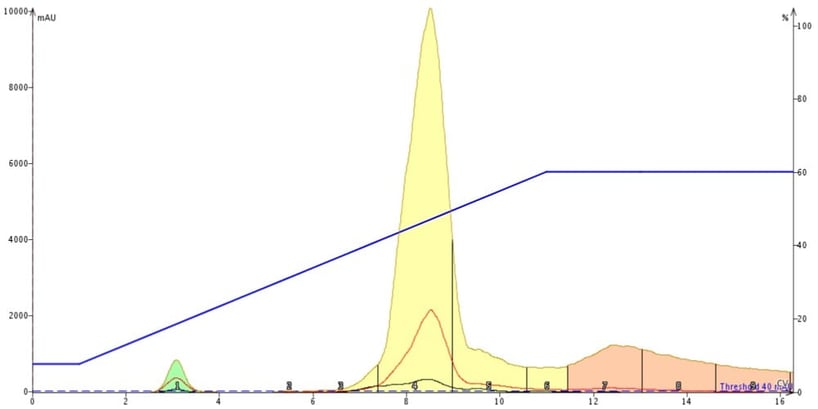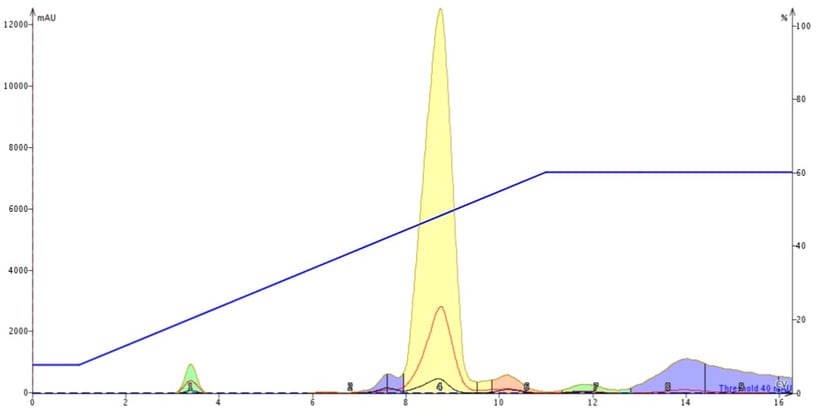Many microwave assisted organic synthesis (MAOS) reactions use polar solvents such as alcohols, DMF, DMSO, because they absorb and transfer microwave energy very efficiently. However, the downside of using polar, microwave absorbing solvents is that they can interfere with normal-phase flash chromatography.
In this post, I discuss why dry loading can be advantageous when purifying polar-solvated reaction mixtures.
Liquid sample loading is simple I use it. I use it when my sample is dissolved in a weak solvent (say DCM) and I am using a silica flash column with a hexane/ethyl acetate gradient. I will even use liquid loading if my sample is dissolved in something more polar, like acetone (when the gradient uses a more polar solvent blend).
I use dry loading, though, when the sample solvent is polar. I have posted on this topic in the past showing examples of dry loading media options and their performance differences and even posted about using an ion exchange media for by-product scavenging.
So, why is liquid injection with polar solvents problematic? Because polar injection solvents adsorb more strongly than many organic reaction products and therefore inhibit the synthetic compounds’ attraction to the stationary phase. The reduced contact time with the media results in earlier elution and a compromised separation.
To address this issue liquid-liquid extraction is often used to remove non-polar reaction products. Since DMF is water soluble, diluting the sample with water, perhaps even a saturated solution of aqueous NaCl, and then extracting into DCM or EtOAc would force the organic materials into the organic solvent which then could be injected into the column. But this is tedious and typically requires several iterations to remove all of the desired product so I prefer the dry loading approach - a simple, quick, 2-step approach.
As part of our product training at Biotage, I instruct my "students" what we refer to as the organic chemistry workflow process. The workflow, of course, begins with synthesis using a Biotage® Initiator+ microwave to synthesize a compound from isatoic anhydride, benzyl amine, acetic acid, and benzaldehyde in DMF. The resulting reaction mixture is a smelly, dark brown solution. Direct injection of the DMF solution provides less than ideal chromatography, Figure 1.
 Figure 1. Normal-phase purification of 1 mL of reaction mixture containing 247 mg of compounds (reagents and product). The large DMF solvent volume diminishes the amount of separation between the product and it nearest impurities which are poorly resolved.
Figure 1. Normal-phase purification of 1 mL of reaction mixture containing 247 mg of compounds (reagents and product). The large DMF solvent volume diminishes the amount of separation between the product and it nearest impurities which are poorly resolved.
In the dry load process, the reaction mixture is added to a sorbent such as silica, Celite®, or Florisil® and the solvent removed via evaporation. For training I use silica and have the students mix 1/3 of the reaction mixture (~1 mL) with 1 gram of silica and evaporate the DMF (we use the Biotage® V-10 Touch for this). After evaporation, I have the student add the dried mixture into either an empty Samplet® cartridge or dry load vessel (DLV) and purify using the same purification method. The results are vastly improved with much improved compound resolution. Now, instead of three clearly defined peaks with a few shoulders we see six well-defined peaks, Figure 2.

Figure 2. Normal-phase dry load purification of reaction mixture (247 mg). With the polar DMF removed, the reaction mixture's components have greater access to the silica, which then provides a better separation.
Dry loading is not limited to polar solvent based reaction mixtures but that is where it really shines.
What have been your experiences with dry loading?
If you would to learn more about flash chromatography, please download our whitepaper Successful flash Chromatography.

